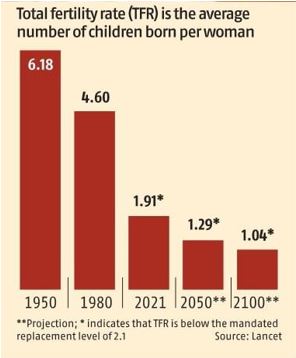

26th March 2024 (12 Topics)
Context
India’s total fertility rate (TFR) is projected to decline to 1.29 children per woman by 2050 and slip further to 1.04 by 2100, according to a recent study by Lancet on global fertility rates.
Key-findings of the Lancet Study
- The study suggests that India’s TFR, or the average number of children born to a woman, has been seeing a decline over the last century, with the fertility rate falling from 6.18 children per woman in 1950 to a projected 1.29 children per woman by 2050.
- The study stated that India has already fallen below the replacement level of fertility, required for a population to exactly replace one generation with another.
- In 2021, India’s TFR was at 1.91 children per woman, below the necessary replacement fertility level of 2.1.
- The decline in TFR is in line with global trends, stating that its estimates forecast a decline in fertility rates all around the globe, over the coming century.
1: Dimension-Reasons behind the fall in the fertility rate
- Delayed marriages: With the delay in the age of marriage, the average age of first pregnancy has dropped from the mid-20’s to mid to late 30’s.
- Women’s workforce participation: An increase in female literacy and women’s workforce participation leads to busy lifestyles in urban areas and high stress jobs. It leads people to not consider having children at all.
- Other factors: The decline in fertility rates is also influenced by factors such as extreme shifts in the global distribution of live births due to:
- improved female education
- increasing usage of modern contraception methods
2: Dimension-Implications for the Economy
- Imbalance: Such a trend will pose challenges such as an ageing population, labour force shortages, and potential social imbalances due to gender preferences in the country.
- Burdened economy: The plummeting fertility rate in developed or high-income countries may result in an ageing population, burdening national health insurance, social security programmes, and healthcare infrastructure.
- Political instability and security difficulties: While the declining fertility rates might appear as a green signal for the environment, the uneven concentration of live births can lead to tense situations across the globe.
3: Dimension-Required Measures
- Economic policies that stimulate growth and job creation, alongside social security and pension reforms are essential in adapting to and mitigating the impacts of declining fertility rates.
- Higher male engagement in household activities: For women to be able to manage careers with motherhood, it would be crucial for men to take greater responsibility for household and care work.
|
Fact Box: Replacement Level
|
More Articles




